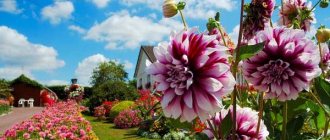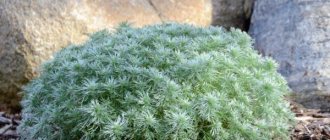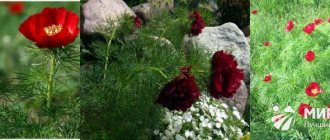Crocosmia, montbretia, tritonia are all names of the same flower, which gardeners also call Japanese or Chinese gladiolus. An unpretentious bulbous perennial plant came to Europeans from Africa.
That flower, which usually pleases the eye in flower beds, was bred through selective breeding by the Frenchman Lemoine. Montbrezia got its name from the name of a French botanist, and crocosmia is translated as “the smell of saffron.”
Indeed, a bouquet of dried crocosmia fills the room with just such a smell.
Montbrecia is an elegant plant with iris-like leaves and spikelets of funnel-shaped stars - flowers of white, yellow, brown, orange or bright red. The arrows of Japanese gladiolus flower growers can be tall and erect, and can smoothly bend between the leaves. The height of the flower spike is from 60 to 150 cm.
The color, height and shape of the inflorescences depend on the variety and variety of crocosmia.
Montbrecia has gained popularity among gardeners due to its long flowering period, which can last from July to September, until the very first frost. Flowers look beautiful in bouquets and remain fresh when cut for up to two weeks.
The bulb of the Japanese gladiolus is small, covered with brown shells. Crocosmia fruits are round capsules with many seeds. You can grow and propagate this flower in your garden by planting corms, plants and seeds.
Growing from seeds
It is easier to grow a plant from seeds if you use the seeding method. For this purpose, prepare containers with soil, which should include peat, sand, turf, and humus. Seeds should be soaked for a day before sowing. For disinfection, you can use a weak solution of potassium permanganate for soaking. After sowing, cover the container with film and place it in a warm, well-lit place.
How to plant bulbs
A week before planting in open ground, the corms are brought into a warm room so that all biological processes are activated. Tubers are planted in early or mid-May. Bulbs are carefully examined; those that are broken or with obvious signs of disease are excluded.
To get rid of all kinds of infections, the tubers are placed in a slightly pink solution of potassium permanganate for half an hour. A large corm is divided into 3-4 parts. You can separate the children to eventually get young plants. The depth of planting corms is about 10 cm. The distance between them should be at least 15 cm. If the soil is insufficient, moistened, the plantings are watered.
Gladiolus crocosmia - planting and care in the garden
Time to board
The right time for planting seedlings in open ground comes when the minimum daily temperatures are no lower than 6 degrees above zero. For the middle zone, this is the end of April - May. The place of permanent residence of the Japanese gladiolus should be an area completely open to sunlight, otherwise the montbretia may not bloom. This plant loves soils in which there is no stagnation of moisture. Constantly wet soil threatens rotting and disease. It is better to prepare a bed for planting crocosmia in the fall. The soil is enriched with humus, lime, phosphate fertilizers and potassium chloride. Nitrogen fertilizers are added in the spring.
Each seedling is placed in a separate hole and watered well. In order for the seedlings to survive transplantation less painfully, you need to make a canopy over it from the sun's rays for 2-3 days.
Planted from seed seedlings, crocosmia does not produce inflorescences in the first year. With good care in a suitable place, flowers can bloom in the second year, usually only in the third.
Growing
Work on planting and caring for Montbretia in open ground is no different from caring for ordinary gladioli and comes down to weekly abundant watering and loosening the soil after watering, and weed removal as necessary.
If the flowerbed occupies a place on fertile soil, there is no need for additional fertilizing. Poor, infertile soils require additional application of organic fertilizers in solution every 10 days, and potassium fertilizers during bud opening.
Reproduction
Every year, many baby shoots grow around the mother bulb, which begin to flower independently the following year. The old corm does not die, but continues to grow further. Caring for Japanese gladiolus includes periodic division and transplantation of daughter bulbs. The bushes are dug up in the fall, and new planting is done in the spring, at the same time as planting seedlings from seeds. You can first plant the bulb in a pot, germinate it a little, and then transfer it to a flowerbed, carefully, along with a lump of earth.
It is advisable to plant different varieties of crocosmia away from each other to maintain purity of color. Those planted together cross-pollinate and lose their brightness.
Possible pests and methods of controlling them
Perennial Japanese gladiolus is a plant resistant to various types of diseases. However, excessively moist soil, as well as excessive drought and infections brought by insects, can cause some diseases.
- Fusarium. Signs: leaves dry out, flower stalks dry and curl, flower color fades. Control: treatment with fungicides.
- Gray rot. Signs: gray plaque affects the bulb, the plant dies. The reason is waterlogging.
- Jaundice. Signs: the tips of the leaves turn yellow, then the whole plant turns into straw and dies. The cause is a viral infection. Control: affected plants do not regenerate, healthy ones must be transplanted to another place, bulbs and seeds should be treated with potassium permanganate before sowing.
- The main pests of Montbrecia are spider mites, mole crickets and thrips. Control: spraying with chemicals, using traditional methods of control, traps for mole crickets.
Care Tips
The Montbretia flower does not require special care. In summer it needs regular watering. It is important not to allow the soil to dry out.
Prolonged drought can destroy the plant.
Experienced gardeners recommend removing old leaves and inflorescences in a timely manner.
In this way, you can preserve the decorative effect of Japanese gladiolus for a long time.
Another interesting point is that the earlier the flowers are cut, the longer the bouquet will please the owners.
Watering, weeding and loosening
It is best to loosen the soil after watering and rain. Loose soil promotes better penetration of oxygen and moisture to the roots of the flower.
Both of these components are very important for the growth and development of Montbretia. Weed removal also cannot be ignored.
Weeds especially interfere with crocosmia at the initial stage of development. Weeds absorb micronutrients from the soil, leaving only a small amount for the flower.
Fertilizer application
For better growth and development, abundant flowering, Japanese gladioli are fed with mineral fertilizers. Do this 3 times.
It is recommended to alternate mineral fertilizing with the application of a solution of manure or bird droppings.
You can prepare the solution as follows:
- Bird droppings or manure are added to the bucket.
- Pour in water and stir thoroughly.
- They insist for several days. During this time, stir constantly.
Before watering, the prepared solution is diluted at a rate of 1:10 and watered over the crocosmia.
The first application of fertilizer is done when leaves appear. The second time is fed before flowering, the third time in the fall.
Garter to support
Some varieties of Montbrecia grow quite tall. It is recommended to tie them up. To do this, they stock up on pegs to which flower stalks are tied.
If this is not done, then under the weight of the inflorescences they may break off. A garter is also needed to ensure that nutrients reach the rhizomes.
It is also important to promptly prune dried, faded inflorescences.
Care after flowering
After Japanese gladioli have finished blooming, they require pruning. At this stage, special care for crocosmia is necessary for the ripening of the bulbs.
This way they will overwinter better in the soil.
If the crocosmia has grown too thick, it needs to be planted. This is done approximately once every 3-4 years.
Control of possible pests and diseases
Japanese gladioli are most often affected by mole crickets and thrips. It is the mole crickets that cause the most damage to plants.
At the first signs of their appearance, it is necessary to immediately treat the bushes with special preparations.
Mole crickets penetrate deep into the soil and gnaw on crocosmia bulbs. The plant begins to hurt, its leaves wither, its bulbs rot.
To control pests, use the drugs Thunder, Grizzly or Medvetox.
You can also use special repellers for prevention, which are sold in agricultural or flower shops.
Digging and storing bulbs in winter
Some varieties of Japanese gladioli remain in the ground for the winter. They tolerate cold well and germinate with the onset of warm weather.
Other types require mandatory storage indoors.
As a rule, varieties with small inflorescences are not afraid of the cold.
Before the onset of cold weather, it is recommended to cover them with sawdust, leaves and cover them with film.
For large-flowered species, bulbs need to be dug up in the fall. With the arrival of October, this procedure is carried out.
You need to act carefully so as not to damage the bulbs. After this, the planting material is dried.
This procedure is mandatory and very important, since the safety of the bulbs depends on it. Poorly dried planting material can rot and disappear.
Next, the bulbs are placed in sand or peat. If there are babies on the bulbs, they are left in place. If separated, they may dry out over the winter.
For storage, it is necessary to maintain an air temperature of no more than +10°C.
The room should be well ventilated.
On a note! Some gardeners use the vegetable compartments of the refrigerator to store planting material.
Crocosmia after flowering
Collecting seeds
Ripe crocosmia seeds are large and yellow-brown in color. After ripening, the seed pods are collected and stored in a dry place. It is best to propagate Chinese gladiolus, which is already growing in the garden, using the vegetative method. And if you really need seeds, it is better to purchase them in a store to avoid infection and cross-pollination.
Preparing for winter
Japanese gladiolus is a perennial; in regions that are not threatened by severe winters with freezing of the soil, crocosmia is not dug up. The bushes are pruned and mulched with compost, sawdust, and spruce branches. In the southern regions, it is enough to cover with leaves and film.
Many gardeners believe that Montbretia is preserved better in the ground than when dug up. When covered tightly, the plant tolerated thirty-degree frosts well. But once every three to four years, digging needs to be done; thick planting leads to crushing and degeneration of flowers.
Reproduction
Crocosmia reproduces by seeds and bulbs. A whole colony grows from one bulb. It is recommended to separate colonies every 3-5 years. This is done in early spring before planting. If this is not done, the crocosmia begins to bloom poorly.
Plants reproduce most quickly from small bulbs. If Montbrecia grows in a region with warm winters, then propagation by self-sowing is possible. To prevent this from happening, wilted flowers are cut off.
You may be interested in: When to dig up gladioli in the fall in 2021: the most favorable days for digging up bulbs Dates for planting gladioli in the spring according to the 2021 calendar of gardeners and gardeners Growing gladioli in pots outdoors
Important! Different varieties of crocosmia are planted at a considerable distance from each other, since they can cross-pollinate.
Types of crocosmia
In total, nature has created about 50 species and 400 cultivars of crocosmia; the following varieties are most often used for cultivation in garden beds:
- Emily McKenzie is a late flowering variety. The flowers are orange-brown with a bright center. The height of the bushes is up to 60 cm.
- Lucifer is a frost-resistant variety, up to one and a half meters high. Straight peduncles with very bright red flowers.
- George Davidson is the most suitable variety for cutting. The flowers are large, bright yellow. Height – up to 70 cm.
- Star of the East is a variety with large, up to 10 cm in diameter, beautiful flowers, apricot color. Disadvantage: poor frost resistance; requires digging up for the winter.
In areas with low temperatures, where the number of sunny days is small, low-growing species of crocosmia are grown in greenhouses for cutting, or as a potted plant.
Description of the plant
Montbrecia is a herbaceous perennial. The height of the plant can be from 60 cm to 150 cm. The rhizomes of the plant are many corms that grow in large clusters. Each tuber is covered with several shells. Crocosmia leaves are narrow, sword-shaped and light to deep green in color. The peduncles are thin, branched and reach up to 1 meter in length.
Crocosmia blooms from June to September. The flowers are star-shaped, about 5 cm in diameter, collected in a long panicle. The buds bloom alternately, starting from the base. In the southern regions of our country, the seeds of this plant have time to ripen.
Reviews from flower growers
For flower growers in Eastern Europe, crocosmia has not yet become a familiar flower, due to the paucity of information and knowledge on how to care for it. But increasingly, Japanese gladiolus is becoming a bright decoration of garden areas, ridges, and alpine slides. Those who have hosted a European guest note the extraordinary beauty of group plantings, original bouquets, and the opportunity to use dry plants in room design.
Disadvantages include the poor cold resistance of some varieties and the need to dig them up for the winter.
No matter how much you love begonias and dahlias, freesias and gladioli, do not buy their tubers and bulbs in incredible quantities. Do not forget that until the next season they will still need to be preserved at home and planted in the garden again in the spring.
- Dahlia (Dahlia)
- Gladiolus (Gladiolus), Tigridia (Tigr >Many beginning flower growers try to stock up more tubers and bulbs in the fall, without thinking about how to properly prepare corms and root-tuberous crops for storage, and in the spring they discover that the planting material is spoiled.
To prevent this from happening, you need to evaluate your capabilities and desires: if you do not have a cellar, garage or glassed-in veranda, that is, any room where you can maintain a temperature of +5 throughout the winter. +8°С, there is no need to chase quantity. Make sure that the tubers and bulbs intended for storage are completely healthy and ripe. When storing planting material, take into account the characteristics of each crop.
During the winter, all stocks are examined at least once a month. If signs of fungal diseases are found - rot, spotting, mold - the affected areas are cleaned and treated with brilliant green or colloidal sulfur. Severely affected tubers and bulbs are removed immediately to prevent them from becoming a source of infection.
How to store a bike in a small apartment
There are many variations on how to place your bike in your living space: from stylish wall mounts that allow you to make your bike a part of your interior, to a simple stand. By the way, before attaching your bike to the wall, take into account its weight and the quality of the walls.
If you don’t want to disassemble your bike for the winter, you can store it against the wall using brackets or a bike rack
When using floor stands, you need to make sure that the stand niches are suitable for the width and size of the wheels.
If these two options do not suit you, it will be enough to place the bike in a case and put it in the storeroom, but be careful not to put anything on it.
Now let's take a closer look at ideas for storing bicycles in a living space.
Mounting a bicycle to the ceiling and wall
Hanging a bicycle is a great way to save space in your apartment. Another good thing about this method is that you don’t have to worry about tire pressure. When you search for hanging bicycle storage in a search engine, you will see a lot of options: from the simplest and most inconspicuous to designer ones that create an element of decor in the room.
The bicycle can be secured to the ceiling using ropes and hooks - this way it will hang horizontally. Another method involves attaching a special frame on which the bicycle is placed, like on a shelf.
When storing on the wall, there are vertical storage, when the bicycle is pulled up by the front wheel, and horizontal, when the bike remains in its position and is fixed on the wall using a bracket on which the bicycle is suspended by the frame. When suspended, the steering wheel can create inconvenience. The problem is solved quickly: just turn it 90 degrees.
Perhaps some readers will be frightened by the apparent complexity of this method, but we hasten to reassure you: the mechanisms necessary for hanging storage are sold in online stores. All you have to do is mount it to the wall.
Hanging storage is an interesting way to display your bikes as a collection if there are several of them, and if there is only one, you can decorate a hobby corner in the same way with photographs, a map of tested routes, medals, and starting numbers. To make the corner beautiful, look at the websites for creative mounting options.
Mounting a bicycle to the wall using a bike rack
A convenient option that serves as an alternative to the previous one is to hang the bike on a special rack. Its advantage is that the height of the hooks can be adjusted.
Nowadays there is a huge offer of different types of racks, and minimalist solutions, like those shown below, seem very good to us.
These options take up little space, but reliably “park” the bike for several months.
You can also purchase a home version of a bike rack, similar to those found in public places. This way you won't have to drill and screw the mount, and the bike will stand securely on the floor. Moreover, the home equivalent of a bike rack is great for families with multiple bikes.
Storing your bike in a closet and other places
The best solution would be to remove the wheels from the bike, twist the pedals inward, lower the saddle and hide the bike in such a compact form - in a closet, or under the bed, or put it on the mezzanine. In this case, we recommend that you first put the bike in a case so as not to inadvertently scratch it.
If you have a large living space, you may want to consider purchasing a special bicycle cabinet. It wins over all options in that its design presents a complete and holistic appearance: the cabinet provides storage for small parts, equipment and tools. That is, you get an organized space specifically for a bicycle.
Many of the storage mechanisms listed require you to hang your bike on one or both wheels. Is it even possible to hang a bicycle by the wheel? Yes, and this is considered one of the best storage methods. Don't worry, the weight won't damage the wheels.
Storing a bicycle on the machine
This is the easiest way, of course, provided that you have a bicycle machine. At the same time, because you have a machine, you most likely do not preserve the bicycle, but continue to use it in the same way. Except perhaps without road dust and sudden precipitation.
If you do not plan to practice on the machine, it is, of course, ideal for storage. Just remember to take care of the pressure in the tires, loosen everything that is tightened during use, and keep it away from direct rays of the sun.
It will be useful: How to choose a bike station for training at home
An option for organizing space in a way that will inspire new sporting victories. Source: kellytheculinarian.com
Storage in specialized places
More and more people get on bicycles in the summer, which means that seasonal storage of bikes in bicycle workshops turns out to be a profitable business in big cities. The areas that are occupied by bicycles waiting in line for maintenance during the active season are given over to winter storage.
In such places, of course, storage rules are strictly observed: it is warm, dry and clean. Most companies accept bikes from September to May and for the entire season they will ask from 4 to 15 thousand rubles, depending on the volume of services.
How are tubers and bulbs of ornamental flowering plants prepared for wintering and stored?
Montbretia, or crocosmia (Montbretia, Crocosmia)
This plant is usually treated like this: at the end of September, the corms are dug up, dried for several days at room temperature, and the corms are separated from the corms. Store at temperature +5. +7°С.
Another method will also work: dig up the bushes entirely, do not shake off the soil, and do not separate the baby. Store dried nests in an open container. If there are a lot of corms, then you can take a chance and leave some of them to overwinter in the soil, mulching with a thick layer of peat (at least 15 cm).
in the photo: flowering crocosmia or montbretia
Dahlia
Dahlias usually suffer greatly from frost. But do not rush to remove them, although all the leaves have turned black, since at this time there is an intensive outflow of nutrients from the stems and leaves into the tubers. Tubers should be harvested at the end of September - beginning of October, with the onset of stable night temperatures of 0 ... + 3 ° C.
Dahlia cultivated
Digging should begin with unhilling the stems. Then, using pruning shears, cut the stems slightly below the hilling level, where the stem has not been exposed to frost. Leave the height of the stump at 8–10 cm. It is best to dig a small trench within a radius of 20 cm around the bush using a shovel and carefully pry up the tubers - do not forget that they are very fragile and weakly attached to the root collar. Do not pull on the stems under any circumstances, as... the roots may break off, which will subsequently lead to the death of the tuber. Carefully inspect the tuber - if there are rotten places or torn roots and tubers, then the diseased areas must be cut out to healthy tissue, and all places of breaks, breaks and cuts must be sprinkled with crushed coal or ash. Then carefully clean the root tuber from the soil and spread it in one layer in a cool place at a temperature of +3...+5°C and a humidity of 85–90%.
Root tubers dahlia
Follow a few important rules.
- Do not dry dahlia root tubers in a warm room at room temperature! Under these conditions, they immediately begin to evaporate a large amount of moisture, and even if the tubers are then transferred to a cool room, this process will continue, the tubers will dry out to a mummified state and will not be reborn.
- Before laying it out for storage, you should check whether there is water in the lower cavity of the stump located above the root collar. To do this, pierce the stump with an awl and tilt it so that the water flows out. If the water is not removed, the tubers will begin to rot.
- Often the infection is introduced when pruning stems, so the pruning shears should be disinfected before pruning each bush.
- Root tubers should only be divided in spring!
After 15–20 days of drying, the tubers must be transferred to a permanent storage location. You can store them in the basement of a house, cellar or vegetable pit, but you should remember that the storage temperature should be +3...+6°C, air humidity 60–75%. It is best to place the tubers in dry sand or fresh sawdust. In winter, you should check the tubers regularly (1-2 times a month), remove rotten areas and sprinkle with crushed coal or ash. During the storage period, there is always waste - both rotten and dried tubers.
Freesia
These tender plants are best grown in containers. They bloom in autumn. To ensure flowering lasts longer, containers with flowers are brought indoors at the end of September. Such a simple solution will allow the corms to ripen properly (this is unattainable outdoors in the middle zone).
After the above-ground part dies, the corms are dug up, washed, disinfected and slightly dried. Recommended storage temperature +26. +30°С. Freesia corms are small and very easy to dry out. Therefore, it is best to put them in sterile, tightly closed jars and place them near heating radiators or pipes. There are other recommendations, but we must honestly admit that not a single method of indoor storage guarantees high-quality flowering.
in the photo: freesia blooming
Where should you not store your bike?
List of potential bike storage spots you should cross off:
- Entrance. A bicycle may attract thieves or disturb other residents of the house.
- Balcony. On an open balcony, as on the street, a bicycle will be exposed to precipitation, dust and sudden temperature changes. This leads to rust, corrosion and large spring maintenance bills.
- Heat sources. Do not place your bike near radiators, radiators or heaters indoors.
- Basement. If there is high humidity in the basement, cross out this option as well.
- Cold or damp garage. The bike does not like the capricious temperature conditions of the off-season, so if the garage is damp and does not maintain a constant temperature, it will not be able to accommodate your friend.
- On the concrete floor. Avoid leaving bicycle tires on the bare concrete floor of a basement or garage. Concrete draws moisture from the rubber of tires, causing them to age prematurely.
From these prohibitions we can derive the formula for an ideal place to store a bicycle: it should be dry, at a constant temperature, hidden from prying eyes.
Caring for Crocosmia montbretia
- The plant likes to be watered abundantly and infrequently.
- After this, you need to weed the area to remove weeds and loosen it.
- If necessary, install pegs for gartering flower stalks.
- For faster growth of shoots, treat the ground under the plant with nitrogen fertilizer.
- In the summer, organic fertilizers diluted tenfold, as well as mineral potassium supplements, will be useful.
- At the end of flowering, all flower stalks are cut off to speed up the ripening of the bulbs and improve the chances of their further preservation.
Growing in a greenhouse
If the site has a solid greenhouse made of glass or polycarbonate, you can germinate corms in April. To do this, they are placed in boxes with soil and watered. Sprouts should appear soon. When the temperature reaches about +10 degrees (late April or early May), Crocosmia is planted in a permanent place.
Crocosmia is an undemanding plant. Montbrecia is watered approximately once every two weeks, but the plant can withstand temporary drought. Weeds are weeded out. If crocosmia is planted on poor soils, then fertilizers are applied once every 10 days. This can be a comprehensive fertilizer for flowering plants.
Crown anemone (Anemone coronaria), Asian buttercup (Ranunculus asiaticus)
After digging, the thickened rhizomes of these plants are washed, treated in a fungicide solution and dried to the state of “crackers”. Store in any box or bag at room temperature. Before planting, soak for a day.
This spring I planted crocosmia bulbs for the first time, they bloomed very late, and with the first frost I brought a pot of blooming crocosmia into the house. After flowering, I cut off the dry leaves, but I don’t know where to store them in the winter - either in a cool room at home, or take them out to a greenhouse, mulch them with humus and cover them with snow. Help with advice.
Blooming crocosmia (and on the left in the flowerpot is acidanthera).
And this is trimmed and prepared for wintering.
Many gardeners are faced with a common problem: how to preserve successfully grown summer planting material of gladioli, begonias, montbretia, acidatera, zantedeschias, dahlias and other heat-loving plants stored until spring planting? The very first failure in storage sometimes forces the gardener to reconsider his attitude towards these beautiful plants and give up trying to grow them due to difficulties in storage. Let's try to figure it out: how to preserve summer-grown tubers, without loss if possible?
Pests and diseases
- Fusarium. With this disease, flower stalks become irregular in shape, leaves turn yellow and die, flowers change color and become deformed. Plants are sprayed with Benomil, and the bulbs are pickled in a Fludioxonil solution before planting.
- Gray rot. A fungal disease that covers the bulbs with a gray coating. This infection is easier to prevent than to cure.
- Jaundice. The plant dies from this virus. The tips of the leaves turn yellow first, and then the entire plant. The disease is spread by cicadas.
Among the pests that are partial to crocosmia are spider mites, thrips, and mole crickets. During prolonged drought, spider mites may appear; these small insects are almost invisible. However, they are dangerous because they drink plant sap and are carriers of infections.
Insectoacaricide preparations will help cope with spider mites. “Aktelik”, “Fitoverm”, “Karbofos” are used against thrips.











